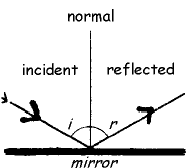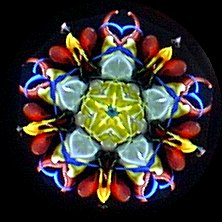BACKGROUND:
Kaleidoscopes use the principles of
symmetry and reflection to create brightly colored displays. A simple
arrangement of mirrors produces multiple images of objects giving the
effect that there are more than one object in an area. Reflection is
when light bounces off a surface at the exact angle it enters.
PROCEDURE:
-
 Draw the diagram
on the right on the board. The ray of light that enters is called the
incident ray and the ray that leaves is called the reflected ray. Draw the diagram
on the right on the board. The ray of light that enters is called the
incident ray and the ray that leaves is called the reflected ray.
-
Ask students where
they have seen evidence of reflection. Perhaps they will mention seeing
one in a mirror or shiny surface, or the reflection in a pond or lake.
Make a list of their encounters with reflection. Ask students what is
unique about a surface that gives good reflections; a polished, smooth
surface is the best. A rough surface creates many reflections causing a
blurry image.
The POST LAB goes
over the reflection that occurs in a kaleidoscope the students have
made. The lab centers around students making their own kaleidoscope and
then comparing theirs to others in the lab to try and find out why they
work. The only differences between the kaleidoscopes are the colors
being reflected. Instruct students to compare theirs with a manufactured
kaleidoscope provided in the module.
-
The directions for
making a kaleidoscope are on the student's lab sheets. Students should
notice there are 3 sections they see when looking through a
kaleidoscope. Students will put beads or other transparent items small
enough to fit into their kaleidoscopes. When the lab is completed, have
students return the beads and small items. Conserve as much as the
material as you can. The image will be blurred if the mylar is not
straight. The students should see 3 sections when they look into these
kaleidoscopes. They should conclude that reflection makes a kaleidoscope
work. If students want to keep their kaleidoscopes, they can find items
at home to put in it.

|